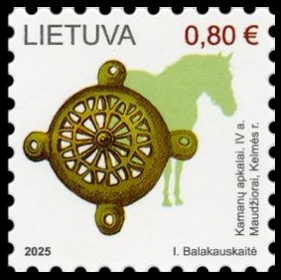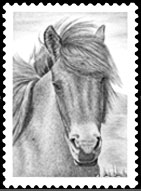
On January 24, 2025, Lithuanian Post issued a series of 3 stamps "Baltic Tribes. Samogitians".
"Baltic Tribes" is an ongoing series of postage stamps that was released in 2024. The first issue was dedicated to the Aukštaiti tribe, and this year's series is dedicated to the Samogitian tribe.
The post office decided to show the culture and traditions of the peoples who inhabited Lithuania in ancient times through archaeological artifacts found in burials in the territories of the tribes' historical residence.
The Balts' desire for beauty was reflected in various areas of material culture, primarily in clothing and jewelry. The Balts achieved high skill in bronze casting and the processing of silver and iron. Casting and forging of metals were widely used to make bronze jewelry. Many jewelry and other items were richly ornamented, for this purpose embossing, engraving and inlay were used.
Among the archaeological finds, head ornaments, neck rings, bracelets, as well as various clasps, brooches and pins are often found.

The series, designed by artist Irma Balakauskaitė, consists of three stamps united by a common concept. Each stamp depicts an ancient piece of adornment with an indication of the place where it was found and its date. Next to it, the artist added male and female silhouettes of the conventional "owners" of these adornments.
The 0.20 and 2.00 euro stamps show a crossbow-shaped brooche from the 7th century and a stepped clasp from the 3rd-4th centuries. They are typical for western and central Lithuania.
The 2024 stamps from the series "Baltic Tribes. Aukštaiti" also depict a crossbow-shaped fibula from the 5th-8th centuries. The second stamp shows a horseshoe-shaped brooch from a later period (11th-13th centuries) with a beautiful complex weave, as if twisted from several bundles.

Such pins, brooches and buckles were used to fasten women's and men's clothing (shirts, shoulder covers, headdresses).
It is interesting that in addition to stamps with men's and women's adornment, a third stamp with adornment for horses appeared. A large number of ancient metal jewelry for horse harnesses and saddles have survived to this day. This is due to the custom, common at that time, of burying a horse in full harness along with a deceased or perished rider.
The horse's equipment consisted of a bridle with bits, a blanket, and a saddle. The most luxurious was, as a rule, the bridle. It was made of leather straps, and the crossing points were fastened with bronze or iron plaques-fittings, often inlaid or completely covered with silver. The bridle straps were decorated with two or three rows of figured decorations, sometimes bells were added. Metal parts were decorated with embossed ornaments or braiding.

The €0.80 stamp has a round forged decoration of a horse bridle in the center, and a silhouette of a horse can be seen to the right. Based on the theme of the issue - the history of the Samogitians - it can be assumed that this is a Samogitian horse. This breed has been known since the 6th-7th centuries, and was used as a war horse by the Lithuanians during the Northern Crusades. The exact origin of the breed is unknown, but Samogitian horses are probably descendants of wild European horses.
A previously popular breed, it was on the verge of extinction several times. First, due to mass crossbreeding with other breeds to obtain larger horses for agriculture, then due to losses in livestock during World War II, and also due to a lack of attention to preserving the breed in the 1990s. Currently, active efforts are being made in Lithuania to restore and popularize the Samogitian horse breed. The center of their breeding is the Vilnius State Stud Farm.
By the way, in 2016 the Lithuanian Post issued a series "Horses" with a block dedicated to the Samogitian breed.
I apologize for any errors or inaccuracies


